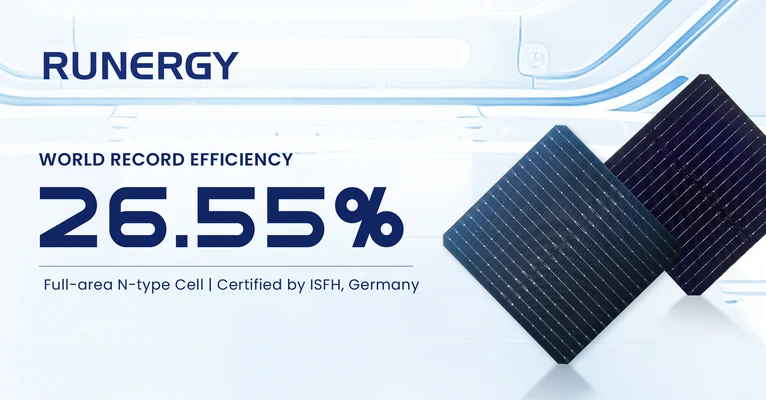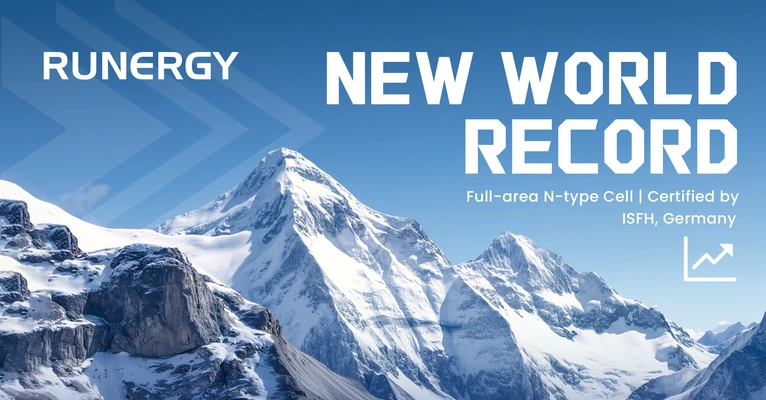Jiangsu Runergy New Energy Technology Co., Ltd. (“Runergy”) has announced that its independently developed M10 full-area N-type solar cell has achieved a conversion efficiency of 26.55%, as certified by the Institute for Solar Energy Research Hamelin (ISFH), Germany.
This result not only breaks Runergy’s previous record but also surpasses the 26.4% full-area N-type TOPCon cell efficiency listed in Solar Cell Efficiency Tables (Version 66), published in Progress in Photovoltaics: Research and Applications by Professor Martin Green, becoming the highest publicly reported efficiency for a full-area N-type solar cell to date.

Verified by an Internationally Recognized Authority
The record-breaking cell was fabricated on Runergy’s pilot-scale production line, using standard-thickness M10 wafers and fully mass-producible processes.
The result was independently verified by ISFH, one of the world’s most respected solar cell testing institutions.
ISFH’s certification is highly authoritative and its test data are regularly referenced in Solar Cell Efficiency Tables, the industry’s benchmark for verified photovoltaic performance.
Dr. Longzhong Tao, General Manager of Runergy and Director of the company’s Photovoltaic R&D Laboratory, emphasized that this achievement reflects the company’s long-term investment in N-type TOPCon 3.0 technology.
“This is not just a new world record for full-area N-type solar cells,” Dr. Tao said.
“What makes it truly meaningful is that the result was achieved on a mass-production-ready pilot line, rather than on a single lab-scale device. It demonstrates that high efficiency and industrial scalability can be achieved simultaneously.”
Technological Innovation Driving Efficiency Breakthroughs
The high-efficiency cell adopts Runergy’s proprietary N-type TOPCon 3.0 technology platform, featuring comprehensive process optimization and the company’s exclusive RunPass passivation technology, achieving Jo_rearpoly < 1 fA/cm².
A high sheet resistance front diffusion combined with hydrogen passivation reduces Joe to below 3 fA/cm², effectively minimizing surface recombination losses and enhancing carrier lifetime.
In addition, Runergy’s R&D team developed a proprietary Powerloss Online Analysis System, which enables real-time quantification of efficiency losses across the entire process chain, including wafer bulk recombination, front diffusion, rear poly-layer absorption, and gridline series resistance.
This data-driven platform provides precise, quantifiable feedback for continuous process optimization and line improvement.

A Global Leader in Cell Manufacturing
Runergy is one of the world’s leading solar cell manufacturers, having ranked Top 3 globally for three consecutive years in solar cell shipments.
The company operates multiple high-efficiency cell production bases in China and Thailand, with a combined production capacity exceeding 63 GW.
Its N-type cell lines have achieved a mass-production average efficiency of 25%–25.5%, positioning Runergy among the industry’s technology leaders.
Leveraging advanced automation and stringent quality management systems, Runergy’s high-efficiency cells are widely used by global module manufacturers and power plant developers across dozens of countries, providing reliable and high-performance power generation solutions.
Runergy’s R&D Institute has invested approximately USD 60 million, holds TÜV Rheinland Witness Laboratory accreditation, and maintains long-term collaborations with multiple international research organizations.
Its research portfolio spans PERC, N-type TOPCon, HJT, BC (Back Contact), perovskite, and tandem cell technologies, supporting a diversified roadmap for next-generation photovoltaic innovation.
From achieving 24.87% efficiency with P-type cells to today’s 26.55% record for N-type cells, Runergy continues to push the boundaries of high-efficiency solar technology through consistent investment, innovation, and industrial implementation.
Industry Significance
Industry experts note that Runergy’s 26.55% record represents not only a new global benchmark for full-area N-type TOPCon cells but also a key breakthrough in the industrialization limits of the TOPCon technology pathway.
This achievement is expected to accelerate the commercialization of high-efficiency N-type cells, contributing to cost reduction, higher energy yield, and better long-term performance in PV applications.
Dr. Tao emphasized that Runergy will continue to refine its TOPCon processes, enhance production-line stability, and drive further efficiency improvements.
“We firmly believe that the combination of high efficiency and scalable mass production will be the cornerstone for achieving affordable solar energy in the coming years,” he said.
Sources: Runergy Research Institute, ISFH Germany
